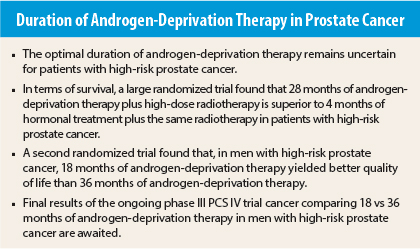Optimal duration of androgen-deprivation therapy as part of primary therapy for prostate cancer continues to be an important question. Two well-conducted studies reported recently at the 56th Annual Meeting of the American Society for Radiation Oncology (ASTRO) provide data that can help inform decision-making, especially for patients with high-risk disease.
The first study showed that 28 months of androgen-deprivation therapy plus high-dose radiotherapy (78 Gy) was superior to 4 months plus the same radiation treatment in extending overall survival and disease-free survival, but the benefit of longer treatment was apparent mainly in men with high-risk prostate cancer. The second study showed that quality of life was superior with 18 months of androgen-deprivation therapy vs 36 months, and clinical outcomes were similar.
Long-Term vs Short-Term Hormonal Therapy
The addition of 28 months of androgen-deprivation therapy (long-term androgen deprivation) to high-dose radiotherapy improved 5-year biochemical disease-free survival, metastasis free-survival, and overall survival compared with 4 months of androgen-deprivation therapy (short-term androgen deprivation) and high-dose radiotherapy as primary treatment of men with intermediate- and high-risk prostate cancer, with most of the benefit seen in men with high-risk disease.1
“Optimal timing and sequence of hormone therapy are extremely challenging for management of patients with intermediate-risk and high-risk prostate cancer,” noted lead author Almudena Zapatero, MD, PhD, Hospital Universitario de la Princesa, Madrid. “The 5-year results of our study show that modern high-dose radiotherapy with 28 months of hormone therapy is a successful combination to control prostate cancer, with good quality of life for patients with high-risk prostate cancer,” she said.
DART 01/05 Study
The multicenter DART 01/05 study, selected as a Plenary Session presentation, enrolled 362 men with intermediate-risk and high-risk prostate cancer at nine centers in Spain between 2006 and 2010. None of the patients had lymph node involvement or metastases at baseline.
All patients were treated with 4 months of concomitant androgen-deprivation therapy and high-dose radiotherapy at a median dose of 78 Gy. Patients were then randomized to two groups: adjuvant goserelin (Zoladex) for an additional 24 months (long-term) or no additional androgen-deprivation therapy (short-term). There were a total of 166 patients with intermediate-risk disease and 189 patients with high-risk disease who were evenly balanced between the two treatment arms.
At a median follow-up of 63 months, 5-year biochemical disease-free survival was 89.8% in the long-term androgen-deprivation group vs 81.3% in the short-term group (P = .019). Metastasis-free survival at 5 years was also significantly higher for the long-term androgen-deprivation group: 93.6% vs 83.4%, respectively (P = .009). Overall survival was statistically superior as well for long-term androgen deprivation: 94.8% vs 86.1%, respectively (P = .009).
These benefits in outcomes were mainly in patients with high-risk disease. Five-year biochemical disease-free survival in patients with high-risk disease was 88% for long-term androgen deprivation vs 75.3% in the short-term group; 5-year overall survival was 96.1% with long-term androgen deprivation therapy and 81.5% with short-term androgen deprivation therapy for patients with high-risk disease, respectively. The magnitude of difference between the two treatment arms was much smaller among patients with intermediate-risk disease; the absolute difference for biochemical disease-free survival was 4% and for overall survival 2%.
Acute and late radiation toxicities were low, Dr. Zapatero reported, with no significant differences between treatment arms.
18 vs 36 months of Androgen-Deprivation Therapy
Testosterone levels recovered more quickly and quality of life was improved in men with high-risk prostate cancer treated with 18 months of androgen-deprivation therapy vs 36 months in a large randomized phase III trial (PCS IV).2 At an interim analysis reported previously in The ASCO Post (July 25, 2013; bit.ly/1rrLBf0), overall and disease-free survival rates from this trial were comparable between the two arms. Final survival results from the ongoing PCS IV trial comparing 18 vs 36 months of androgen-deprivation therapy are awaited.
At the ASTRO meeting, lead author Abdenour Nabid, MD, Centre Hospitalier Universitaire de Sherbrooke Canada, presented new data from the PCS IV trial on testosterone levels and quality-of-life data from the trial.
The study enrolled 561 men with high-risk prostate cancer and randomized them to either 18 months of androgen-deprivation therapy plus radiation therapy or 36 months of androgen-deprivation therapy plus radiation therapy. For both groups, radiation therapy was given 4 months after the initiation of androgen-deprivation therapy.
Measurements of serum testosterone were obtained at baseline and at each follow-up visit. At a median follow-up of 84 months, testosterone levels recovered to normal in 55.7% of patients treated with 18 months of androgen-deprivation therapy vs 44.9% in the 36-month androgen-deprivation therapy group. Time to recovery of normal testosterone levels was shorter in the 18-month group compared with the 36-month group: a median of 47.2 months vs 73.2 months, respectively.
Using two validated quality-of-life tools (EORTC30 and EORTC25) totaling 55 items grouped into 21 scales (evaluated from 0–100 points), patients were assessed prior to treatment, every 6 months during androgen-deprivation therapy, 4 months post–androgen-deprivation therapy, and once a year for 5 years after treatment.
Quality of life was more improved in patients whose testosterone levels recovered to normal compared with those whose levels did not reach this benchmark. In fact, 26 of the 55 items, as well as 12 of the 21 scales were significantly improved in those with testosterone recovery vs those with no testosterone recovery. These scales were clinically relevant and included sexual activity, ability to exercise, fatigue, pain, emotional functioning, and global health status, Dr. Abdenour said.
“These results are not surprising, considering the side effects of [androgen-deprivation therapy] and the fact that testosterone recovery has a significant impact on improved quality of life. In high-risk prostate cancer, the current guideline for [androgen-deprivation therapy] duration is 2 to 3 years. Before we have final results of the ongoing phase III PCS IV trial, it is a good idea to treat with androgen-deprivation therapy for 2 years instead of 3,” he said. ■
Disclosure: Drs. Zapatero and Abdenour reported no potential conflicts of interest.
References
1. Zapatero A, Guerrero A, Maldonado J, et al: Randomized phase III trial of adjuvant androgen deprivation in combination with high-rose conformal radiotherapy in intermediate- and high-risk localized prostate cancer. 56th ASTRO Annual Meeting. Abstract PL-02. Presented September 15, 2014.
2. Nabid A, Carrier N, Martin A, et al: Quality of life in patients with testosterone recovery after long-term androgen deprivation therapy for high-risk prostate cancer. Annual Meeting of ASTRO. Abstract 24. Presented September 15, 2014.




